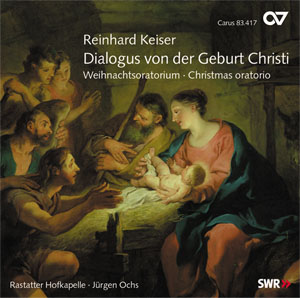
Dialogus von der Geburt Christi
This world premiere recording of the Weihnachtsoratorium by Reinhard Keiser makes available one of the few surviving sacred works by a musician who was highly regarded by his contemporaries, primarily as a composer of operas. Well-known Christmas chorales, opulently scored, with rich polyphony, are joined by movements which depict with great delicacy the secene around the crib at Bethlehem. This CD includes, also recorded for the first time, the Magnificat by Christoph Graupner, written in 1772 to support his application for the post of Thomaskantor in Leipzig.
Purchase
Additional product information
Contents
-
Composer
Reinhard Keiser
| 1674-1739
-
Preface writer
Christine Blanken
-
Ensemble
Rastatter Hofkapelle
The Rastatter Hofkapelle was formed along the lines of the original court orchestra and is made up of eight solo singers plus instrumentalists. The aim of the ensemble is to perform the sacred music of the former court music directors in Rastatt and the works of other Baroque composers, observing historical performance practice. More exact information concerning the makeup of the court orchestra is to be found in a court calendar of 1764. According to this source, it consisted of the music director, the concert master, an organist, seven singers and 19 instrumentalists, as well as four trumpeters and a timpanist. All of the members of the Rastatter Hofkapelle are active both as soloists and as members of distinguished professional ensembles concerned with the interpretation of early music. Personal details
-
Conductor
Jürgen Ochs
Jürgen Ochs studied church music at the Staatliche Hochschule für Musik in Karlsruhe, concentrating on the organ and conducting. He studied singing at the Musikhochschule in Dortmund, concluding with the concert examination. His favorite works include the Bach Passions (singing the evangelist roles), cantatas, oratorios of the classical and romantic periods, Lieder, and song cycles. Since 1991 Jürgen Ochs has been the district choirmaster of the Freiburg Archdiocese, first at Breisach Minster, and in the meantime at the Catholic municipal church of St. Alexander in Rastatt. He is the conductor of the chamber choir Capella Crucis, and of the Rastatter Hofkapelle. He is also professor of singing at the Hochschule für Kirchenmusik in Rottenburg/Neckar. Personal details
-
Soloist - soprano
Beate Spaltner
-
Soloist - soprano
Ursula Benzing
-
Soloist - alto
Judith Ritter
-
Soloist - alto
Matthias Lucht
-
Soloist - tenor
Raimund Sturm
-
Soloist - tenor
Jürgen Ochs
Jürgen Ochs studied church music at the Staatliche Hochschule für Musik in Karlsruhe, concentrating on the organ and conducting. He studied singing at the Musikhochschule in Dortmund, concluding with the concert examination. His favorite works include the Bach Passions (singing the evangelist roles), cantatas, oratorios of the classical and romantic periods, Lieder, and song cycles. Since 1991 Jürgen Ochs has been the district choirmaster of the Freiburg Archdiocese, first at Breisach Minster, and in the meantime at the Catholic municipal church of St. Alexander in Rastatt. He is the conductor of the chamber choir Capella Crucis, and of the Rastatter Hofkapelle. He is also professor of singing at the Hochschule für Kirchenmusik in Rottenburg/Neckar. Personal details
-
Soloist - bass
Johannes Happel
-
Soloist - bass
Claus Temps
Frequent questions about this work
 There are no questions and answers available so far or you were unable to find an answer to your specific question about this work? Then click here and send your specific questions to our Customer Services!
There are no questions and answers available so far or you were unable to find an answer to your specific question about this work? Then click here and send your specific questions to our Customer Services!





